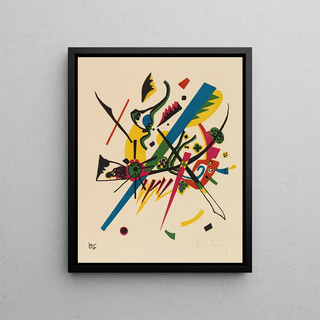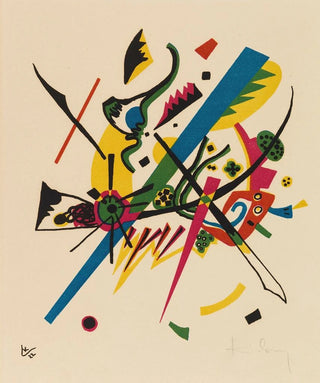Art print | Small worlds I - Wassily Kandinsky


View from behind

Frame (optional)
In the fascinating universe of modern art, few works manage to capture the collective imagination like "Petits mondes I" by Wassily Kandinsky. This iconic piece, emerging from a time when abstraction was gaining momentum, invites the viewer to embark on a visual and emotional journey. Through organic shapes and vibrant colors, Kandinsky does not merely depict reality; he transcends it, opening a door to unexplored inner worlds. The art print of "Petits mondes I" allows for an appreciation of this artistic exploration, offering a window into the mind of a master who combined pictorial sensitivity with profound reflections on music and color.
Style and uniqueness of the work
"Petits mondes I" stands out for its unique approach to abstraction. The piece consists of geometric shapes and fluid patterns, creating a harmonious balance between chaos and order. The colors, bright and carefully juxtaposed, seem to vibrate on the canvas, evoking a variety of emotions. Circles, lines, and splashes of color combine to form a landscape where each element appears to dialogue with the others. This dynamic interaction between shapes and hues reveals Kandinsky's bold vision, who believed that color could evoke sensations similar to those of music. Contemplating this work, the viewer is invited to feel rather than analyze, to let themselves be carried by the sensations each nuance evokes.
The artist and his influence
Wassily Kandinsky, an emblematic figure of the expressionist movement, left a mark on art history with his innovative approach. Born in Russia in 1866, he was one of the first artists to explore pure abstraction. Influenced by music, he considered art as a form of spiritual expression, capable of transcending words. Kandinsky also played a key role in founding the Bauhaus, a school that revolutionized visual arts and architecture. His legacy endures today, inspiring generations of artists to explore the boundaries of abstraction and seek new ways to express emotions.

Matte finish

View from behind

Frame (optional)
In the fascinating universe of modern art, few works manage to capture the collective imagination like "Petits mondes I" by Wassily Kandinsky. This iconic piece, emerging from a time when abstraction was gaining momentum, invites the viewer to embark on a visual and emotional journey. Through organic shapes and vibrant colors, Kandinsky does not merely depict reality; he transcends it, opening a door to unexplored inner worlds. The art print of "Petits mondes I" allows for an appreciation of this artistic exploration, offering a window into the mind of a master who combined pictorial sensitivity with profound reflections on music and color.
Style and uniqueness of the work
"Petits mondes I" stands out for its unique approach to abstraction. The piece consists of geometric shapes and fluid patterns, creating a harmonious balance between chaos and order. The colors, bright and carefully juxtaposed, seem to vibrate on the canvas, evoking a variety of emotions. Circles, lines, and splashes of color combine to form a landscape where each element appears to dialogue with the others. This dynamic interaction between shapes and hues reveals Kandinsky's bold vision, who believed that color could evoke sensations similar to those of music. Contemplating this work, the viewer is invited to feel rather than analyze, to let themselves be carried by the sensations each nuance evokes.
The artist and his influence
Wassily Kandinsky, an emblematic figure of the expressionist movement, left a mark on art history with his innovative approach. Born in Russia in 1866, he was one of the first artists to explore pure abstraction. Influenced by music, he considered art as a form of spiritual expression, capable of transcending words. Kandinsky also played a key role in founding the Bauhaus, a school that revolutionized visual arts and architecture. His legacy endures today, inspiring generations of artists to explore the boundaries of abstraction and seek new ways to express emotions.






